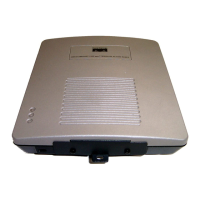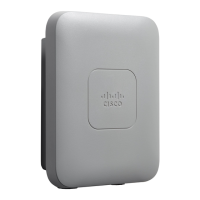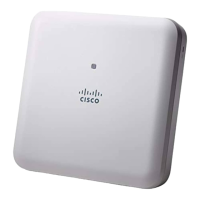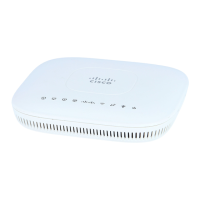3-5
Cisco Aironet 1250 Series Access Point Hardware Installation Guide
OL-8247-03
Chapter 3 Troubleshooting 1250 Series Autonomous Access Points
Checking Basic Settings
Table 3-2 lists the power injector LED indications.
Checking Basic Settings
Mismatched basic settings are the most common causes of lost connectivity with wireless clients. If the
access point does not communicate with client devices, check the following areas.
Default IP Address Behavior
When you connect a 1250 series access point running Cisco IOS Release 12.4(10b)JA or later software
with a default configuration to your LAN, the access point requests an IP address from your DHCP
server and, if it does not receive an IP address, continues to send requests indefinitely.
Enabling the Radio Interfaces
In Cisco IOS Release 12.4(10b)JA or later, the access point radios are disabled by default, and there is
no default SSID. You must create an SSID and enable the radios before the access point will allow
wireless associations from other devices. These changes to the default configuration improve the
security of newly installed access points. Refer to the Cisco IOS Software Configuration Guide for Cisco
Aironet Access Points for instructions on configuring the SSID.
To enable the radio interfaces, follow these instructions:
Step 1 Use your web-browser to access your access point.
Step 2 At the prompt, enter the administrator username and password. The default username is Cisco and the
default password is Cisco. The username and password are case sensitive.
Step 3 When the Summary Status page displays, click Network Interfaces > Radio0-802.11N
2.4GHZ
and the
radio status page displays
Note The module slot (slot 0 or slot 1) where the radio module is located defines the Radio0 or Radio1
designation. See Figure 1-1 on page 1-3 for the location of the module slots.
Step 4 Click Settings and the radio settings page displays.
Step 5 Click Enable in the Enable Radio field.
Step 6 Click Apply.
Step 7 Click Radio1-802.11N
5GHZ
and the radio status page displays.
Table 3-2 Power Injector LED Indications
LED Color Description
AP Power Green Indicates DC power is available to the access point.
Fault Red Indicates a short or overload condition. Check Ethernet cables and
connections before contacting your support organization for assistance.
AC Power Green Indicates AC power is available at the power injector.

